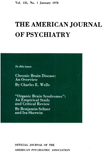The Anatomy of a Delirium
Abstract
The authors describe characteristics of postoperative delirium observed in 60 patients. The typical delirious patient was over 60, had undergone cardiac or orthopedic surgery, became delirious on the third postoperative day and recovered by the seventh, was as likely to be retarded and apathetic as restless and fearful, and had a 50 percent chance of minor cognitive impairment or dismissal. The patient's age and length of illness affected his prognosis; type of treatment did not.
Access content
To read the fulltext, please use one of the options below to sign in or purchase access.- Personal login
- Institutional Login
- Sign in via OpenAthens
- Register for access
-
Please login/register if you wish to pair your device and check access availability.
Not a subscriber?
PsychiatryOnline subscription options offer access to the DSM-5 library, books, journals, CME, and patient resources. This all-in-one virtual library provides psychiatrists and mental health professionals with key resources for diagnosis, treatment, research, and professional development.
Need more help? PsychiatryOnline Customer Service may be reached by emailing [email protected] or by calling 800-368-5777 (in the U.S.) or 703-907-7322 (outside the U.S.).



